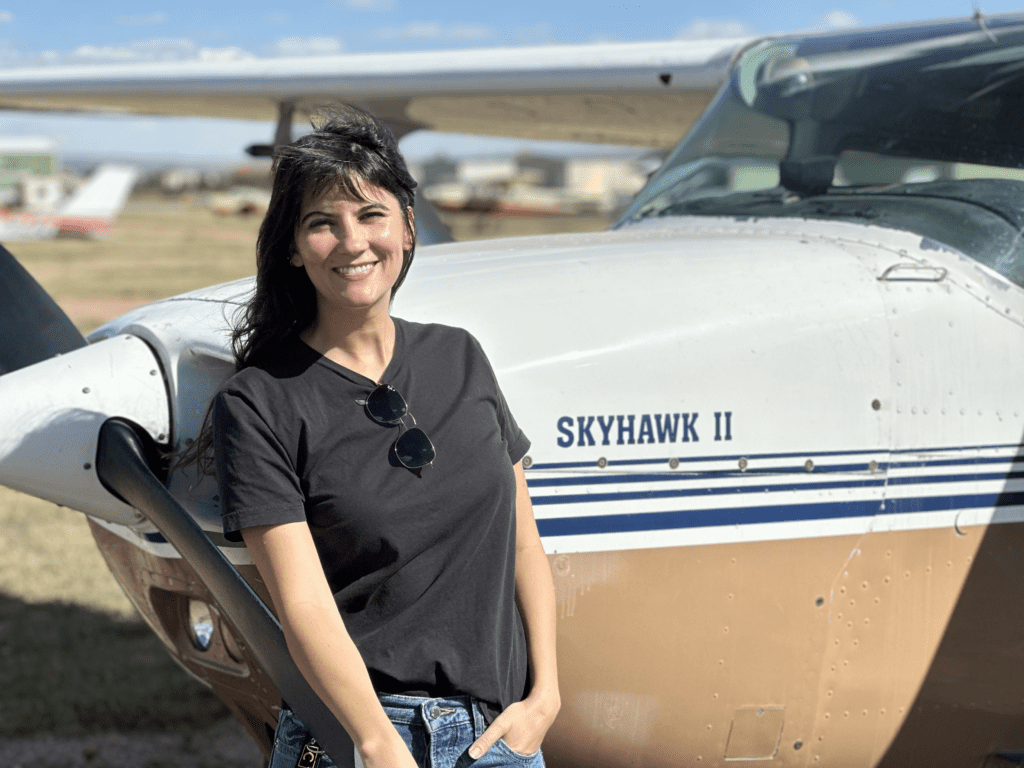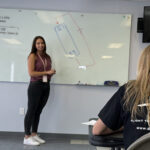Buying your own airplane to make your training faster, safer and more efficient is often perceived as a particularly expensive way to earn your ratings. You might be surprised, however, to learn that buying your own aircraft for flight training may actually save you quite a lot of money. At The Flight School at Colorado Springs, we’re happy to help you find, purchase, maintain and train in your own aircraft.
Disclaimer: The Flight School at Colorado Springs is not staffed by financial advisors. Nothing here should be construed as financial advice. Speak with financial and legal professionals before undertaking any major investment for the first time, such as purchasing a personal aircraft.
Money Problems: Flight Training is Too Expensive
Flight training is ridiculously expensive for most young pilots seeking an aviation career. With high rental costs, instruction costs, materials, ground schools, testing fees and more, it’s no wonder the direct cost of a Private Pilot Certificate often totals well over $15,000.
Typical Flight Training Costs
At The Flight School at Colorado Springs, we can help you earn your ratings more affordably without compromising on safety, but we can’t control the volatile cost of gas, insurance or parts. Prices everywhere continue to rise. We do our best to stabilize prices and offer you the best deals around, but as much as we try, there’s no avoiding the simple fact that flight training is expensive.
Unforeseen Costs
The big price tags on flight training don’t typically include often unforeseen costs, like driving to and from an airport. The further away you live, the worse it gets; auto-related receipts can stack up the more and longer you have to commute.
Perhaps the least tangible but biggest cost is measured in terms of the time you take away from other things in your life. And it’s not just the time driving to and from the airport—which can be substantial, too. We believe the best way to train is full-time, but who has the luxury of foregoing work to go to school when school costs so much?
Hidden Training Costs
- Transportation To/From Airport
- Time Off Work
- Childcare
- Convenience Costs
- Maintenance Delays
- Weather Delays
- Family Emergencies
It’s not a mystery why many go looking for cost-saving measures when flight training. At The Flight School at Colorado Springs, we can help guide you through flight training with a number of cost-saving strategies designed for everyone. Products like virtual ground schools, pre-pay accelerated training packages and bulk flight time discounts can help immensely. One of the strategies we love to talk about is leasing back your own aircraft to help offset what you pay for training.
Sticker Shock: Buying a Training Aircraft Isn’t Cheap
If you’re lucky enough to have the cash to buy your own aircraft and be the only one to fly it, good on you! Most, however, don’t have the sort of cash to purchase a $50,000-plus piece of flying equipment and cover maintenance at shop prices of $150/h or more plus parts, pay hangar fees of $600/month or more, bankroll the several-thousand-dollar insurance premium and then, on top of all that, buy gas, oil and instruction while learning to fly—not including the other costs outlined above.
Aircraft Marketplaces: Where To Buy
There’s a solution to this “my airplane needs a pile of money” problem: put your airplane to work for you with a leaseback agreement.
Leaseback: An Affordable Way to Own
Leaseback agreements can make owning an aircraft achievable—even for those with relatively little capital. This sort of agreement involves buying an aircraft, then leasing it to a flight school for use in its training operations.
In exchange for a cut of the revenue your aircraft generates (typically 25%, sometimes more), the school provides maintenance at a reduced price (or, if you’re lucky, at cost) and handles all of the insurance, fuel bills and marketing to ensure your airplane flies as much as it can. It’s a symbiotic relationship.
Typical Aircraft Expenses On Leaseback
In many cases, an aircraft leaseback becomes a particularly profitable way to own an aircraft. We’ve seen the right aircraft make owners thousands of dollars per month in net income—that’s after the school’s cut, gas costs and maintenance fees.
Leaseback Risks
We’ve also seen leaseback deals go awry, so you should be aware of a few risks to leaseback agreements.
Not Enough Leverage
Just like a house or very expensive car, finding the capital to invest in an aircraft purchase isn’t easy. So, often, people borrow the funds needed to acquire an aircraft.
Even before you can take the substantial risk of borrowing on an airplane purchase, obtaining a loan for an aircraft typically requires solid credit and a steady income. In 2024, aircraft loans aren’t cheap, either. With interest rates so high, a borrower can expect to see rates as high as 11% or 12%. With a typical requirement of about 25% down, a five-year loan will mean a hefty monthly payment.
Obtaining a loan for an aircraft typically requires solid credit, proof of a steady income and often at least 25% down.
Bad Buys
Few common training aircraft are purchased new by students or most small to mid-sized flight schools. New aircraft cost hundreds of thousands of dollars and rarely make financial sense for most training operations. Instead, buying a used aircraft is often the way to go. Like buying any used piece of equipment, however, buying a used aircraft comes with substantial risk.
While ensuring the aircraft logs are complete and paying for a thorough pre-buy inspection can certainly help, no mechanic worth her wrenches will tell you an aircraft you buy is going to be a “sure thing.” You may buy an aircraft and soon come to discover that the engine needs an overhaul sooner than anticipated. Your mechanic may find structural damage that was missed during a pre-buy. There may be corrosion inside a fuel tank. The list goes on, but you get the idea: there’s always a risk.
Not all issues discovered post-purchase mean the aircraft is a bad buy, but when buying any aircraft, be prepared to put more money into it as soon as it’s yours. Once the initial issues are worked out, the flow of money out for maintenance typically calms down for a while.
The Wrong Make, Model or Avionics
I once knew a mechanic who liked shiny stuff. He’d buy all sorts of unique and interesting projects that seemed like a great deal, fix them up and offer them for rent at his buddy’s flight school. Every time he did this, however, he’d eventually have to take the plane off the flight line and sell it.
When this mechanic I knew added a Grumman to a fleet of Cessnas, it didn’t fly much. The only low-wing trainer in the fleet, the aircraft handled so differently than the other primary trainers that it was flown only by a few select students and instructors who preferred it.
When the mechanic found a great deal on a Cessna 150 with a beefier engine and added that to the fleet too, we found that because the upgraded engine’s paperwork didn’t permit substantial increase in the allowable gross weight of the plane, the two-seater could only be legally flown by two adults with a reduced fuel load for a more-limited period of time. It didn’t really catch on at the flight school except among the youngest, lightest students, and the mechanic eventually sold the plane.
When the mechanic added another 172, but with a G1000, to the fleet of exclusively-six-pack avionics, the much-more-expensive aircraft was almost exclusively flown by advanced students—of which there were far fewer.
A flight school relies on workhorse training aircraft. Typically, flight schools operate mostly-homogenized fleets—it’s common to see a school with a fleet of nearly all Cessna 172s and/or Piper Cherokees. Some schools standardize avionics and offer all G1000 trainers to ensure that no matter which aircraft a student books, they’ll know what to expect.
If you plan to leaseback an aircraft, find out what your flight school knows will be in demand before you start shopping. Even if buying the aircraft you need is more expensive, finding the right offering will undoubtably earn more revenue and help pay for your aircraft costs and flight training more effectively.
Maintenance Woes
Ask any pilot or mechanic: aircraft need maintenance—and a lot of it. From 50 hour oil changes to 100 hour inspections to annual inspections, aircraft are carefully supervised to ensure safe working order. While not all schools are as conscientious, every time a student, renter or instructor at The Flight School at Colorado Springs squawks an issue with an airplane, a mechanic takes a look.
Often small issues are resolved quickly. But sometimes, they’re not. This can mean days, weeks or even months of downtime—all while the expense of owning and hangaring the plane continues.
Weather and Delays
During icy months, aircraft won’t fly as much. This means that a leaseback may pay you thousands when nice Summer weather sees everyone out learning to fly, only to require you to pay for maintenance and hangar costs when it’s too cold for most to fly.
Dry-Leasing Options
Leaseback revenue isn’t constant unless you dry-lease an aircraft, which often means a much lower profit margin. A dry-lease means the flight school assumes much more of the risk that the aircraft won’t fly or may need more maintenance on its own (depending on the terms of the contract) and thus pays you much less to use your aircraft. For this reason, schools don’t dry-lease aircraft from private owners as often.
Aircraft Ownership Sounds Miserable. Why Would I Ever Do This?
Even done right, owning an aircraft involves substantial risk and often causes major headaches. But it can also be quite rewarding. The opportunity to pay for most of your training and learn more about aviation along the way may be enough of a motivation. Many find the ability to say, “I own my own airplane” motivation enough. Others focus on the joy of being able to fly wherever, whenever.

Whatever your reason, just as there are many reasons not to own an aircraft, there are also many reasons to own an aircraft.
The Benefit In The Margins
If you’re not in aviation, owning an airplane is a bad idea. But if you’re going to be training anyway, a leaseback is a more-risky way of paying for your flight training. Best case scenario you’ll see a return great enough to pay for your flight training and you’ll end up with your own aircraft to fly whenever it’s not being used for training. Absolute worst case scenario you end up spending your hard-earned money on a pile of metal that costs you more in maintenance and headaches than your training is worth, all before you finish your own training.
Career Benefits
Many students finish training entirely before purchasing an aircraft. Traditional wisdom often offers that the more experience you have before you buy an aircraft, the better. In some sense, this is true: you’ll have more experience in more aircraft and better know what type of aircraft works for you and why.
But if you’re hoping an airplane purchase will reduce the cost of your training, it might. And if you’re planning for a career in aviation, having a training aircraft to your name that you can immediately begin teaching others in as soon as you become an instructor yourself is a huge benefit.
The reward of owning your aircraft goes beyond training for instructors and time-builders. Talk to a CPA about specifics, of course, but purchasing an aircraft to teach in is acquisition of a business asset and you may be able to expense many of the costs associated with operating the aircraft.
At The Flight School at Colorado Springs, we pay our CFIs more than other established schools in the area because we don’t want them worrying about making rent or paying for groceries while teaching you to fly. Unfortunately, market pay for CFIs is notoriously low—many don’t even receive the majority of what you as a student pay for instruction.
Trying to balance training debt with expenses can be difficult on a low salary. But for CFIs who own their own planes, the pay can be higher because they can often be their own boss and keep all or nearly all of their own rate. If you consider that it typically takes about two years of teaching to reach the magic 1500 airline-required hours, then calculate how much money you can make if you’re profiting on both aircraft and your own time during this period, owning the asset you use to teach becomes a risk much more worth taking.
Time-Building Benefits
Time-building in your own aircraft can offer major discounts if you aren’t teaching. Not only can you split time and cost with others to help pay for fuel, you won’t need to pay the premium and profit margin most rental outfits charge on planes you would otherwise use to build time.
This is especially true of multi-engine aircraft time-building, as major premiums are placed on multi rentals because of the engine-wear multi training often sees. In time building operations, this isn’t necessarily the case.
Educational Benefit
Many mechanics, pilots and aircraft owners have told me “you don’t know how to take care of an aircraft until you own an aircraft” and while I vehemently disagree that proper aircraft care can’t be taught, I do understand some of the sentiment; owning an airplane will teach anyone a lot about aviation.
A common lament among mechanically-inclined airplane owners goes something like, “I wish I would’ve tracked all the time I’ve worked alongside my A&P while fixing things—I’d be an A&P by now!” The amount of time and effort devoted to learning how aircraft works certainly pays off: simply by working on aircraft, I’ve become a better pilot. I understand better how to manage an engine, reduce fuel consumption and better care for gear, brakes, tires and more because I’ve helped take them apart and understand how they work.

It isn’t necessary to own an airplane to find this experience (we often conduct ground training in our maintenance hangar and pilots are permitted to conduct limited maintenance operations) but owning an aircraft is sure a great motivator to get you more involved.
Owning an aircraft also teaches business and helps you appreciate the beauty and opportunity of our rich general aviation community.
The Pursuit of Happiness
The pilots who own the airplanes we operate at The Flight School at Colorado Springs often take the planes on cross-country trips to visit family, go to business meetings and even on vacation to Mexico or the Bahamas. The freedom and pleasure of owning and flying your own airplane is difficult to match.
When Should I Purchase an Aircraft for Training?
We recommend looking into aircraft purchase after becoming a private pilot and after deciding you’re certain you’ll want to continue your training through commercial and instructor ratings. A used-but-well-maintained training aircraft will cost somewhere between $40,000 and $200,000 (specific, right?), so you’ll want to carefully consider what your options are regarding financing and leaseback terms before you begin shopping.
Is A Leaseback Right For You?
That’s up to you. At the Flight School at Colorado Springs, we’re happy to work with our students and community members to facilitate leaseback options whenever possible. We do, however, want to ensure that everyone is aware of the risks and rewards involved. While certainly not a venture for those who want things to be simple, owning an aircraft is a potentially rewarding investment in your own training.






